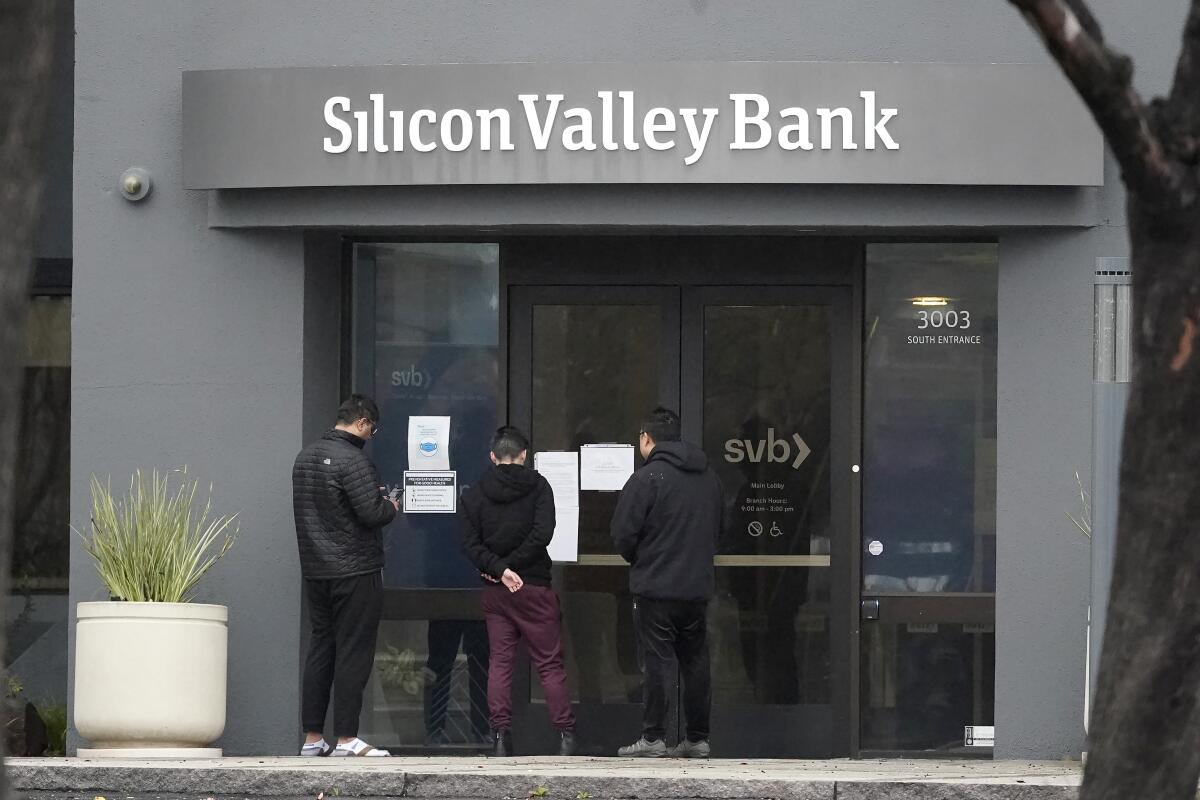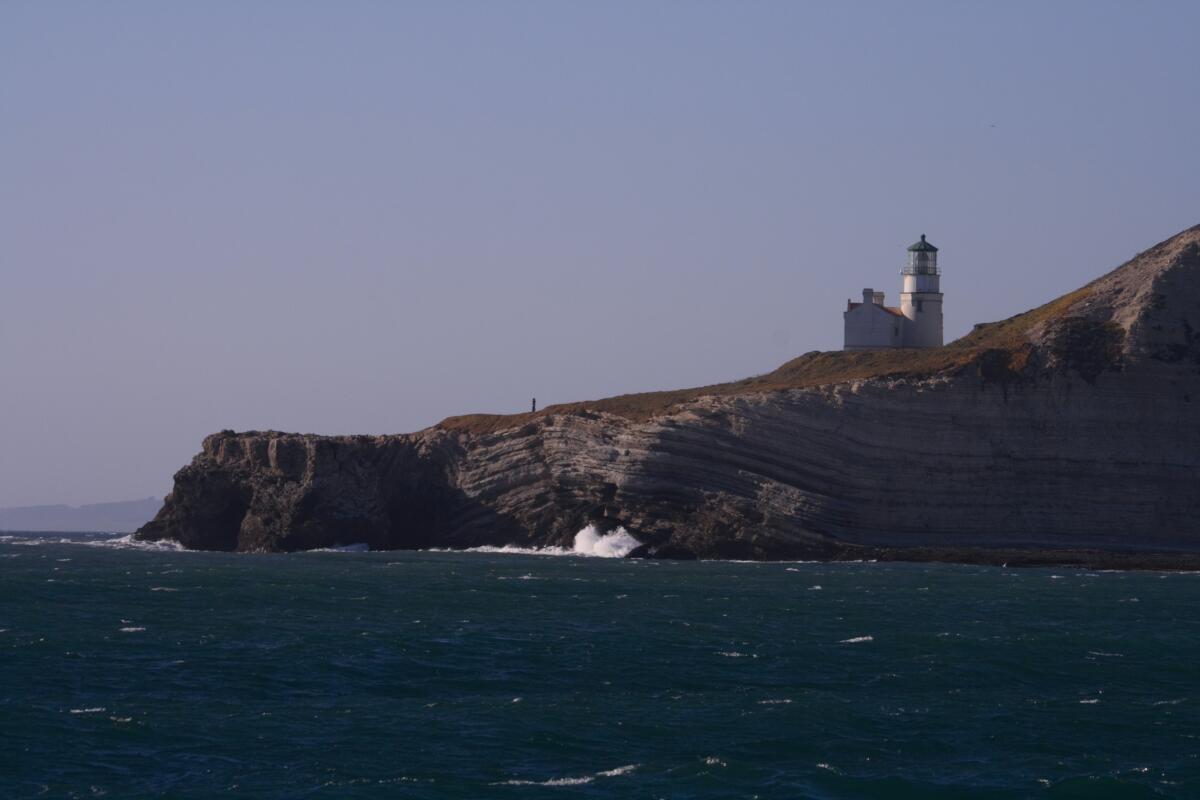What to know about Silicon Valley Bankâs collapse

Good morning, and welcome to the Essential California newsletter. Itâs Tuesday, March 14.
Itâs been a hectic and historic few days for regional banks and the tech companies that have their money stockpiled in them.
Silicon Valley Bank, or SVB, collapsed late last week as venture capitalists pulled out billions of dollars in a short time span. The California Department of Financial Protection and Innovation shut down SVB on Friday and federal regulators stepped in to take control.
It was the second biggest bank failure in U.S. history, followed a few days later by the third biggest. On Sunday, federal regulators shut down New York-based Signature Bank after a run on that bank sparked by fears over the collapse of SVB.
How did this happen?
Basically everything I know about a bank run I learned from âItâs a Wonderful Life.â What happened with SVB followed the same basic playbook, but unlike George Baileyâs small-town clientele, SVB managed billions of dollars from tech startups and the venture capitalist firms that pick the industryâs winners and losers. And on Thursday alone, those investors and depositors pulled a whopping $42 billion out of SVB.
Times tech industry columnist Brian Merchant summed up the collapse like this:
- SVBâs large deposits âwere bound up in low-interest securities, and they came from venture capital-backed companies that were burning through cash faster than expected.â
- The bank and its many startup clients are âbeholden to a relatively small cadre of venture capitalists,â leaving SVB âuniquely exposed to a run on the bank should those venture capitalists decide to pull their funds at the same time.â
The catalyst federal officials and financial experts point to is rising interest rates that had been reducing the market value of the bankâs assets.
SVBâs leadership should have seen this coming, Merchant writes, arguing that the bankâs involvement in an âinherently haphazard systemâ put it at risk. He explained:
If SVB was vulnerable to a rapid run-up in interest rates, itâs because it catered to an industry where showering unproven companies with cash is the norm, with venture capitalists competing among themselves to see who can make it rain the hardest.
The last few days were chaotic for many tech companies that had accounts there â and to some of the clients that rely on their services. One such business, Wrapbook, processes payrolls for entertainment production companies. The collapse led to delayed payrolls on Friday and froze processing for uncashed checks.
The intervention by the U.S. government allowed SVB clients to access their funds again, meaning Wrapbook could resume processing payrolls beginning Monday. The company said it expects to be âfully operationalâ by Wednesday.
What is the federal government doing about it?
Bailing the depositors out.
The U.S. Treasury Department, Federal Reserve and Federal Deposit Insurance Corp. announced last weekend that all depositors with money in SVB would be able to get to their money again Monday. That includes customers with more than the FDIC-covered $250,000 insurance limit.
President Biden addressed the issue Monday ahead of his three-day trip to California and Nevada, promising that the bailout would not fall on taxpayers and vowing to hold the banksâ management and investors accountable.
âThey knowingly took a risk, and when risks donât pay off, investors lose their money,â Biden tweeted Monday. âThatâs how capitalism works.â
What does this mean for the broader economy?
Understandably, two major bank failures in three days is bound to stir economic anxiety.
In his remarks Monday morning, Biden said âAmericans can have confidence that the banking system is safe.â But Wall Street doesnât seem so convinced as investors opened the market by selling off shares in several regional banks.
First Republic Bank saw shares plummet 78%. Other hard-hit institutions include Western Alliance Bancorp, PacWest Bancorp and Comerica Inc.
So what about all us regular, non-VC bank customers?
âFor most individuals and businesses, the right course is to do nothing,â writes Jon Healey, senior editor for The Timesâ Utility Journalism team.
In his explainer on the bank collapse, Healey notes that the median bank account(s) balance among Americans is $5,300 per household, per a 2019 Federal Reserve survey. The average amount across American bank customers is $41,600.
The FDIC insures our deposits at each bank we use up to $250,000. And since the vast majority of banks are insured through the FDIC (you can confirm your bankâs status using this online directory), the average person with a bank account should be covered if the situation spirals.
But banking experts say what happened with SVB and Signature Bank were unique sets of circumstances that do not signal widespread doom.
Add to that the âaggressiveâ government response Monday, Healey writes, and analysts contend that âdepositors in other banks can stay put rather than shifting into crisis mode.â
And now, hereâs whatâs happening across California:
Note: Some of the sites we link to may limit the number of stories you can access without subscribing.
Check out "The Times" podcast for essential news and more
These days, waking up to current events can be, well, daunting. If youâre seeking a more balanced news diet, âThe Timesâ podcast is for you. Gustavo Arellano, along with a diverse set of reporters from the award-winning L.A. Times newsroom, delivers the most interesting stories from the Los Angeles Times every Monday, Wednesday and Friday. Listen and subscribe wherever you get your podcasts.
POLITICS AND GOVERNMENT
Officials and engineers had known for decades that a levee that failed in Santa Cruz County during the weekend storm was at risk of failing. As my colleague Susanne Rust reports, repairs to the the Pajaro River levee were never made âin part because they believed it did not make financial sense to protect the low-income area.â Los Angeles Times
Californiaâs community college system is exploring ways to reduce the financial burden textbook costs put on many students. One idea some campuses are pursuing is publishing their own textbooks and course materials. CalMatters
California Democrats are pushing forward to strengthen the stateâs role as an abortion rights haven. Lawmakers introduced a package of 17 bills Monday, including some aimed at enhancing privacy protections. Los Angeles Times
In the high-profile race to fill the L.A. City Council seat vacated when Nury Martinez resigned, a few big progressive groups have kept a low profile. Some far-left activists point to a weaker ground game in the San Fernando Valley district, which includes the neighborhoods of Lake Balboa, North Hollywood, Van Nuys and Sun Valley. Los Angeles Times
Support our journalism
HEALTH AND THE ENVIRONMENT
The Sierra snowpack is now over 200% its average for early March. Thatâs more good short-term news as much of the state marks downgraded drought statuses, but experts warn that more wild swings are in store for California long-term. The Sacramento Bee
The East Coast lobster industry is taking on the West Coastâs famous aquarium. Via its Seafood Watch program, the Monterey Bay Aquarium put American lobsters on its do-not-eat list, citing threats to rare whales that could get tangled in fishing gear. Maine Lobstermenâs Assn. and other industry groups are now suing the aquarium for defamation. Associated Press
CALIFORNIA CULTURE

Tired: bike tours. Wired: railbike tours. You can now sit back, relax and enjoy the scenery as you pedal your way (with electric assistance) along 17 miles of railroad tracks in Ventura County. Los Angeles Times
When Cerritos College basketball coach Russ May put Kade West, who is deaf and has autism, into a game late last year, it marked a beautiful moment for the passionate player, his team and fans. But the coach had broken a bylaw in letting the 20-year-old play, leading to a suspension, a forfeit game and West being temporarily stripped of his uniform. Los Angeles Times
Free online games
Get our free daily crossword puzzle, sudoku, word search and arcade games in our new game center at latimes.com/games.
AND FINALLY
Todayâs California landmark is from Tuck Donnelly of Santa Barbara: Point Conception.

Donnelly writes:
Point Conception marks the turning point on the California coast, where the coastline turns from a north-to-south direction to a west-to-east direction. It is a critical juncture for mariners. To the north of Point Conception the weather can be monstrously rough and windy, while to the south the waters are relatively safe and protected. Mariners, especially in small vessels, cross that line in either direction with great anticipation. The Point Conception lighthouse is one of Californiaâs earliest. Often shrouded in fog, the light and the point are beautiful sights to see.
What are Californiaâs essential landmarks? Fill out this form to send us your photos of a special spot in California â natural or human-made. Tell us why itâs interesting and what makes it a symbol of life in the Golden State. Please be sure to include only photos taken directly by you. Your submission could be featured in a future edition of the newsletter.
Please let us know what we can do to make this newsletter more useful to you. Send comments to [email protected].
Sign up for Essential California
The most important California stories and recommendations in your inbox every morning.
You may occasionally receive promotional content from the Los Angeles Times.




